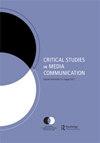想象一个体贴的家:谷歌Nest和家庭录音的逻辑
IF 1.5
2区 文学
Q3 COMMUNICATION
引用次数: 0
摘要
Google Nest家庭安全系统提供一系列摄像头、传感器和互联网连接设备,允许房主监控和记录房屋的外部和内部,并通过智能手机应用程序控制面板自动控制各种加热和冷却、照明和其他电器的功能。本文分析了从2015年到2021年,谷歌是如何通过广告和公司博客文章围绕Nest构建一个虚构的世界的。通过扩展谷歌搜索引擎和其他产品的采掘经济来理解Nest摄像头,我们分析了谷歌如何将Nest定位为一种既能控制又能方便家庭的设备。Control向房主暗示,这个系统可以让他们更有能力保护自己的家,但前提是他们愿意不断使用Nest系统,并允许谷歌自动从家里提取数据。方便意味着Nest可以简单、自动、被动地记录一天中发生在家里的事情。通过这一分析,我们展示了围绕新兴智能家居技术的想象是如何有目的地掩盖了它们让谷歌等公司能够从家中提取数据的方式。本文章由计算机程序翻译,如有差异,请以英文原文为准。
Imagining the thoughtful home: Google Nest and logics of domestic recording
ABSTRACT The Google Nest home security system offers an array of cameras, sensors, and Internet-connected devices to allow homeowners to monitor and record the exterior and interior of their home and automate various functions of heating and cooling, lights, and other appliances through smartphone application control panels. This article analyzes how Google has worked to construct an imaginary around Nest through advertising and company blog posts from 2015 to 2021. Extending the extractive economies of Google’s search engine and other products to understand Nest cameras, we analyze how Google has positioned Nest as a device for both control and convenience within the home. Control suggests to homeowners that this system gives them greater capacity to secure their home, but only if they are willing to constantly engage the Nest system and allow Google to extract data from the home automatically. Convenience suggests that Nest allows easy, automated, and passive recording to capture things that happen within the home throughout the day. Through this analysis, we demonstrate how imaginaries around emergent smart home technologies purposefully mask the ways they give companies like Google the ability to extract data from the home.
求助全文
通过发布文献求助,成功后即可免费获取论文全文。
去求助
来源期刊

Critical Studies in Media Communication
COMMUNICATION-
CiteScore
2.10
自引率
0.00%
发文量
34
期刊介绍:
Critical Studies in Media Communication (CSMC) is a peer-reviewed publication of the National Communication Association. CSMC publishes original scholarship in mediated and mass communication from a cultural studies and/or critical perspective. It particularly welcomes submissions that enrich debates among various critical traditions, methodological and analytical approaches, and theoretical standpoints. CSMC takes an inclusive view of media and welcomes scholarship on topics such as • media audiences • representations • institutions • digital technologies • social media • gaming • professional practices and ethics • production studies • media history • political economy. CSMC publishes scholarship about media audiences, representations, institutions, technologies, and professional practices. It includes work in history, political economy, critical philosophy, race and feminist theorizing, rhetorical and media criticism, and literary theory. It takes an inclusive view of media, including newspapers, magazines and other forms of print, cable, radio, television, film, and new media technologies such as the Internet.
 求助内容:
求助内容: 应助结果提醒方式:
应助结果提醒方式:


